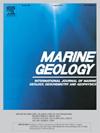Application potential of UK′37 and TEX86H palaeothermometers in high-energy strait-type marginal seas: a case study in the Taiwan Strait
IF 2.2
3区 地球科学
Q2 GEOSCIENCES, MULTIDISCIPLINARY
引用次数: 0
Abstract
UK’37 and TEX86H palaeothermometers are widely applied to sea surface temperature (SST) reconstructions in global oceans. However, their applications in marginal seas often yields biased results due to regional environmental factors. This study investigated the applicability and controlling factors of these proxies in the subtropical, high-energy Taiwan Strait (TS). Utilizing a 35-year dataset (1982–2016) of AVHRR and MODIS-derived annual and seasonal average SST archives, we conducted regression analyses on UK’37 and TEX86H proxies of 58 surface sediment samples from the study area. Additionally, we employed Empirical Orthogonal Function (EOF) analysis to elucidate the physical processes influencing the index reliability. TEX86H-reconstructed SSTs exhibit a cold bias of −5.5–0.3 °C compared to observed SSTs, largely due to seasonal upwelling and terrestrial inputs. Conversely, UK’37-reconstructed SST in the muddy sediment zone of the northern TS shows a warm bias of 1.8–6.3 °C, relative to observed SST, attributable to lateral transport processes in the said environment. By accounting for terrestrial influences as the main non-temperature factor, we developed an improved regional calibration equation for TEX86H-SST in the TS. These results highlight the necessity of considering hydrodynamic effects when applying UK’37 index in such marginal seas. Through modern calibration using surface suspended particulate matter (SPM) and hydrodynamic correction, this study effectively mitigates lateral transport interference, providing a robust framework for palaeotemperature reconstruction in strong hydrodynamic strait-type marginal sea environments.
UK’37和TEX86H古地温计在高能海峡型边缘海的应用潜力——以台湾海峡为例
UK ' 37和TEX86H古温度计被广泛应用于全球海洋的海表温度重建。然而,由于区域环境因素,它们在边缘海域的应用往往产生有偏差的结果。研究了这些指标在副热带高能台湾海峡的适用性及其控制因素。利用35年(1982-2016)AVHRR和modis衍生的年平均和季节平均海温数据,对研究区58个表层沉积物样本的UK ' 37和TEX86H代理进行了回归分析。此外,我们采用经验正交函数(EOF)分析来阐明影响指标信度的物理过程。与观测到的海温相比,tex86h重建的海温表现出−5.5-0.3°C的冷偏,这主要是由于季节性上升流和陆地输入。相反,UK’37重建的北TS泥质沉积带海温相对于观测海温偏暖1.8 ~ 6.3°C,这是由于该环境的侧向输运过程所致。通过考虑陆地影响作为主要的非温度因素,我们建立了改进的TS中TEX86H-SST区域定标方程,这些结果突出了在边缘海应用UK ' 37指数时考虑水动力效应的必要性。通过海面悬浮颗粒物(SPM)的现代定标和水动力校正,有效减轻了横向输运干扰,为强水动力海峡型边缘海环境的古温度重建提供了强有力的框架。
本文章由计算机程序翻译,如有差异,请以英文原文为准。
求助全文
约1分钟内获得全文
求助全文
来源期刊

Marine Geology
地学-地球科学综合
CiteScore
6.10
自引率
6.90%
发文量
175
审稿时长
21.9 weeks
期刊介绍:
Marine Geology is the premier international journal on marine geological processes in the broadest sense. We seek papers that are comprehensive, interdisciplinary and synthetic that will be lasting contributions to the field. Although most papers are based on regional studies, they must demonstrate new findings of international significance. We accept papers on subjects as diverse as seafloor hydrothermal systems, beach dynamics, early diagenesis, microbiological studies in sediments, palaeoclimate studies and geophysical studies of the seabed. We encourage papers that address emerging new fields, for example the influence of anthropogenic processes on coastal/marine geology and coastal/marine geoarchaeology. We insist that the papers are concerned with the marine realm and that they deal with geology: with rocks, sediments, and physical and chemical processes affecting them. Papers should address scientific hypotheses: highly descriptive data compilations or papers that deal only with marine management and risk assessment should be submitted to other journals. Papers on laboratory or modelling studies must demonstrate direct relevance to marine processes or deposits. The primary criteria for acceptance of papers is that the science is of high quality, novel, significant, and of broad international interest.
 求助内容:
求助内容: 应助结果提醒方式:
应助结果提醒方式:


